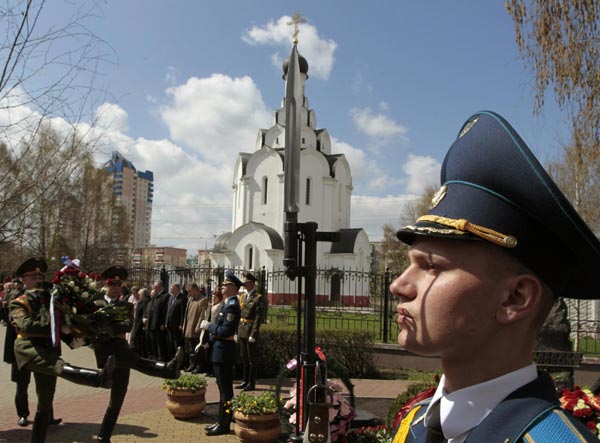 |
|
Guards of honour march with a wreath during a memorial ceremony for Chernobyl victims in Minsk April 26, 2012. Belarus, Ukraine and Russia marked the 26th anniversary of the Chernobyl disaster, the world's worst civil nuclear accident, on Thursday. [Photo/Agencies] |
Nearly 30 years have passed since the nuclear accident at Chernobyl, and the scientific community is still arguing about the impact radiation is having on the ecosystem surrounding the reactor. Recently, together with other scientists, I studied the animals in the human exclusion zone around the plant.
The results were shocking: whatever the impact of radiation on animals may be, the effects of human habitation seem to have been a lot worse. The site offers a stark reminder that humans' simple, physical presence in a habitat is more damaging than one of the 20th century's worst environmental catastrophes.
We studied animals in the nearly 2,200-square-kilometer sector of the exclusion zone in Belarus called the "Polessye State Radioecological Reserve". Before the disaster, this area was home to 22,000 people in 92 villages, and the land was farmed and exploited for its forest resources. In the days after the accident, the area's human residents were evacuated with their farm animals to protect them from high levels of radiation.
Even though radiation levels have dropped by a factor of nearly 100 in the months after the accident, the area is still judged unfit for human habitation. There are few reports on the effects of the accident on wild animals, but we know that in some radiation hot spots trees and wildlife died.
Some people might expect, nearly 30 years later, the area around the reactor to remain a wasteland, sparsely populated by genetically damaged animals exposed to chronic radiation across multiple generations. The reality is very different. Indeed, as early as a few years after the accident, data collected by Belarusian scientists conducting helicopter surveys over the abandoned area showed rising numbers of wild boar, elk and roe deer.
And, with the passage of time, the region's wildlife population continued to grow, as animals made use of what people had left behind. Crops, gardens and orchards provided abundant food supplies. Abandoned houses and farm buildings offered ready-made nests and dens. By 1993, the number of wild boars had increased six-fold, before halving because of a disease outbreak and predation from the rapidly growing wolf population.

I’ve lived in China for quite a considerable time including my graduate school years, travelled and worked in a few cities and still choose my destination taking into consideration the density of smog or PM2.5 particulate matter in the region.